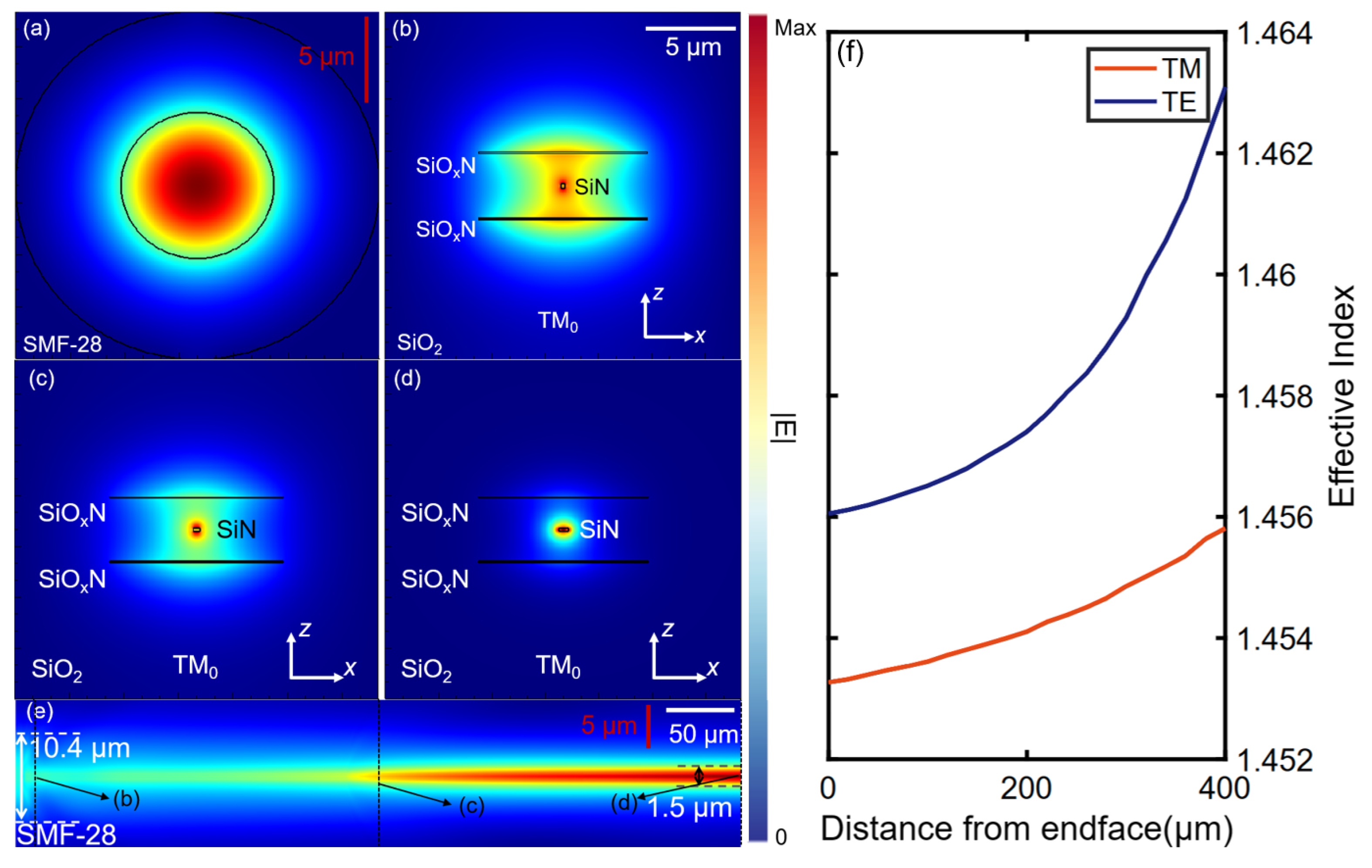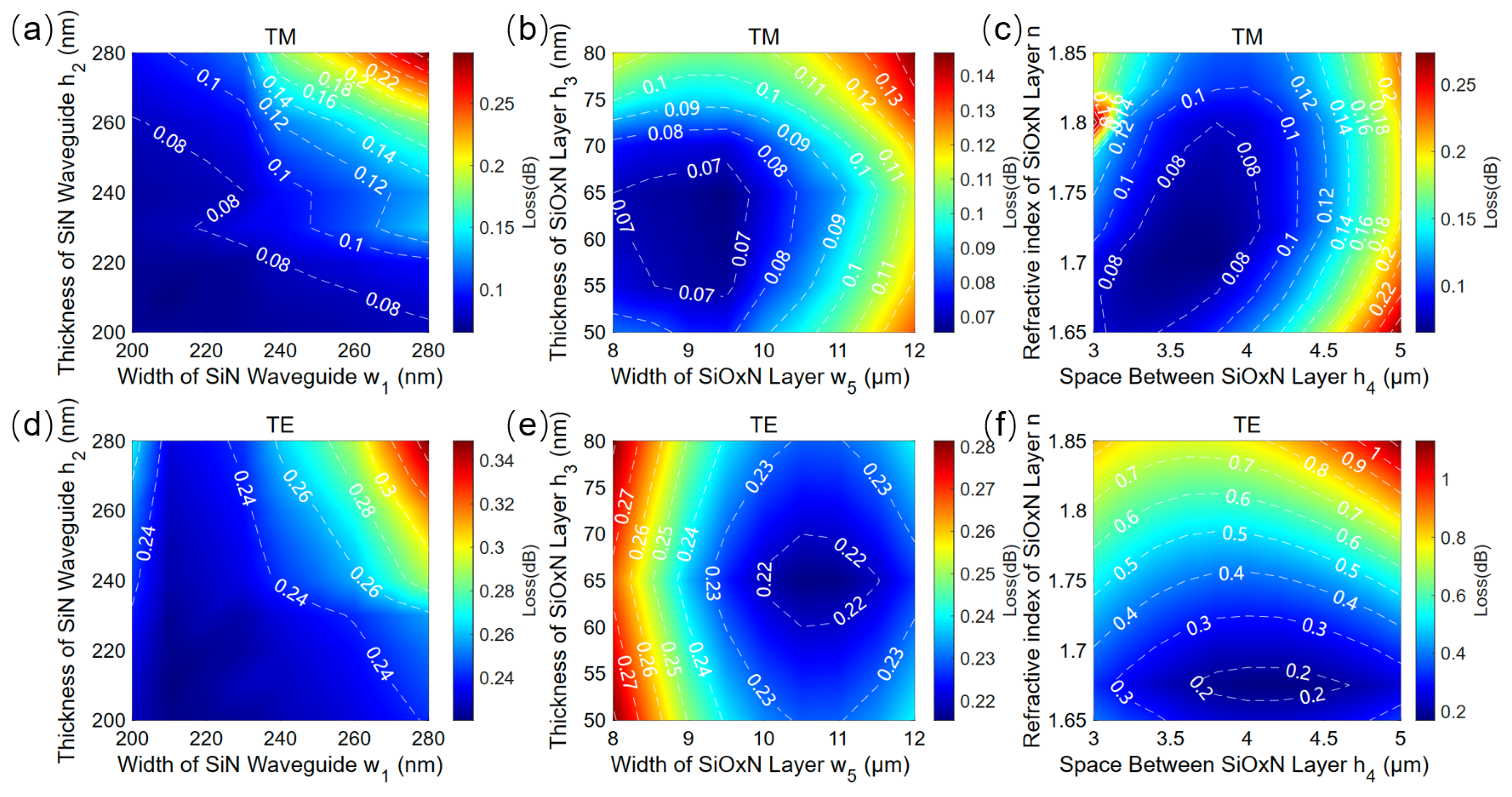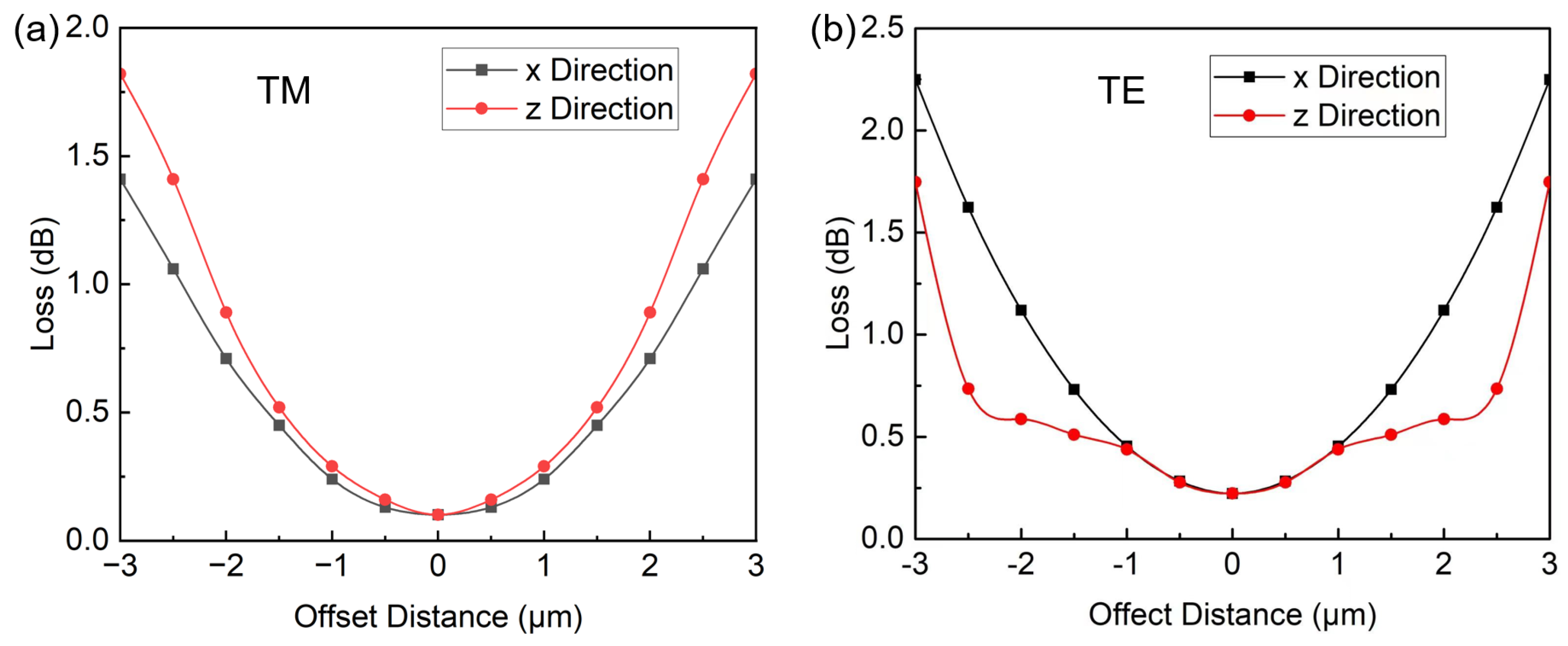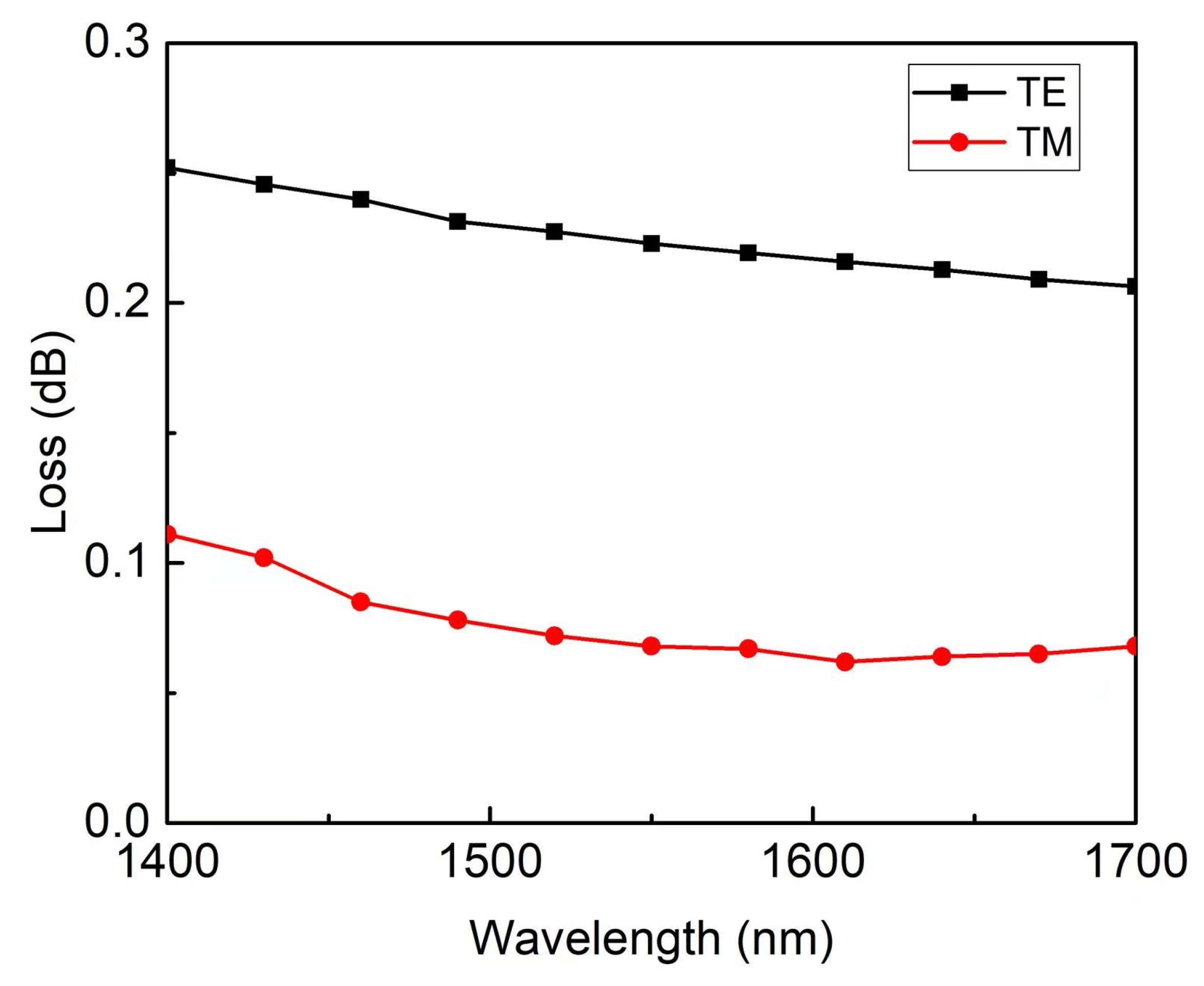A Theoretical Sub-0.1 dB Loss Single Mode Fiber-To-Chip Edge Coupler for Silicon Nitride Waveguides
Abstract
:1. Introduction
2. Device Structure and Operation Mechanism
3. Device Performance
4. Discussion
5. Conclusions
Author Contributions
Funding
Institutional Review Board Statement
Informed Consent Statement
Data Availability Statement
Conflicts of Interest
References
- Jalali, B.; Fathpour, S. Silicon Photonics. J. Light 2006, 24, 4600–4615. [Google Scholar] [CrossRef]
- Chen, X.; Milosevic, M.; Stankovic, S.; Reynolds, S. The Emergence of Silicon Photonics as a Flexible Technology Platform. Proc. IEEE Inst. Electr. Electron. Eng. 2018, 106, 2101–2116. [Google Scholar] [CrossRef] [Green Version]
- Bogaerts, W.; Perez, D.; Capmany, J.; Miller, D. Programmable photonic circuits. Nature 2020, 586, 207–216. [Google Scholar] [CrossRef] [PubMed]
- Takahashi, H. Planar lightwave circuit devices for optical communication: Present and future. Proceedings of Conference on Active and Passive Optical Components for WDM Communications III, Orlando, FL, USA, 14 August 2003; pp. 520–531. [Google Scholar]
- Subbaraman, H.; Xu, X.; Hosseini, A.; Zhang, X. Recent advances in silicon-based passive and active optical interconnects. Opt. Express 2015, 23, 2487–2510. [Google Scholar] [CrossRef] [PubMed] [Green Version]
- Marchetti, R.; Lacava, C.; Carroll, L.; Gradkowski, K.; Minzioni, P. Coupling strategies for silicon photonics integrated chips. Photonics Res. 2019, 7, 201–239. [Google Scholar] [CrossRef]
- Mu, X.; Wu, S.; Cheng, L.; Fu, H.Y. Edge Couplers in Silicon Photonic Integrated Circuits: A Review. Appl. Sci. 2020, 10, 1538. [Google Scholar] [CrossRef] [Green Version]
- Son, G.; Han, S.; Park, J.; Kwon, K.; Yu, K. High-efficiency broadband light coupling between optical fibers and photonic integrated circuits. Nanophotonics 2018, 7, 1845–1864. [Google Scholar] [CrossRef]
- Takei, R.; Suzuki, M.; Omoda, E.; Manako, S. Silicon knife-edge taper waveguide for ultralow-loss spot-size converter fabricated by photolithography. Appl. Phys. Lett. 2013, 102, 101108. [Google Scholar] [CrossRef]
- Bakir, B.; de Gyves, A.; Orobtchouk, R.; Lyan, P. Low-Loss (<1 dB) and Polarization-Insensitive Edge Fiber Couplers Fabricated on 200-mm Silicon-on-Insulator Wafers. IEEE Photon. Technol. Lett. 2010, 22, 739–741. [Google Scholar] [CrossRef]
- Roelkens, G.; Dumon, P.; Bogaerts, W.; Van Thourhout, D. Efficient silicon-on-insulator fiber coupler fabricated using 248-nm-deep UV lithography. IEEE Photon. Technol. Lett. 2005, 17, 2613–2615. [Google Scholar] [CrossRef] [Green Version]
- McNab, S.; Moll, N.; Vlasov, Y. Ultra-low loss photonic integrated circuit with membrane-type photonic crystal waveguides. Opt. Express 2003, 11, 2927–2939. [Google Scholar] [CrossRef]
- Hatori, N.; Shimizu, T.; Okano, M.; Ishizaka, M. A Hybrid Integrated Light Source on a Silicon Platform Using a Trident Spot-Size Converter. J. Light Technol. 2014, 32, 1329–1336. [Google Scholar] [CrossRef]
- Tu, Y.; Fu, P.; Huang, D. High-Efficiency Ultra-Broadband Multi-Tip Edge Couplers for Integration of Distributed Feedback Laser with Silicon-on-Insulator Waveguide. IEEE Photon. J. 2019, 11, 6602113. [Google Scholar] [CrossRef]
- He, A.; Guo, X.; Wang, T.; Su, Y. Ultracompact Fiber-to-Chip Metamaterial Edge Coupler. ACS Photonics 2021, 8, 3226–3233. [Google Scholar] [CrossRef]
- Wang, X.; Quan, X.; Liu, M.; Cheng, X. Silicon-Nitride-Assisted Edge Coupler Interfacing with High Numerical Aperture Fiber. IEEE Photon. Technol. Lett. 2019, 31, 349–352. [Google Scholar] [CrossRef]
- Sun, S.; Chen, Y.; Sun, Y. Novel Low-Loss Fiber-Chip Edge Coupler for Coupling Standard Single Mode Fibers to Silicon Photonic Wire Waveguides. Photonics 2021, 8, 79. [Google Scholar] [CrossRef]
- Tummidi, R.; Webster, M. Multilayer Silicon Nitride-based Coupler Integrated into a Silicon Photonics Platform with <1 dB Coupling Loss to a Standard SMF over 0, S, C and L optical bands. In Proceedings of the Optical Fiber Communications Conference and Exposition, San Diego, CA, USA, 8–12 March 2020. [Google Scholar]
- Lang, X.; Chen, Y.; Yang, L. A high coupling efficiency fiber-to-chip edge coupler with four auxiliary thin layers. In Proceedings of the Eighth Symposium on Novel Photoelectronic Detection Technology and Applications, Kunming, China, 9–11 November 2021; pp. 1590–1596. [Google Scholar]
- Cheben, P.; Xu, D.; Janz, S.; Densmore, A. Subwavelength waveguide grating for mode conversion and light coupling in integrated optics. Opt. Express 2006, 14, 4695–4702. [Google Scholar] [CrossRef]
- Cheben, P.; Bock, P.; Schmid, J. Refractive index engineering with subwavelength gratings for efficient microphotonic couplers and planar waveguide multiplexers. Opt. Lett. 2010, 35, 2526–2528. [Google Scholar] [CrossRef] [Green Version]
- Cheben, P.; Schmid, J.; Wang, S.; Xu, D. Broadband polarization independent nanophotonic coupler for silicon waveguides with ultra-high efficiency. Opt. Express 2015, 23, 22553–22563. [Google Scholar] [CrossRef]
- Papes, M.; Cheben, P.; Benedikovic, D.; Schmid, J.H.; Pond, J.; Halir, R.; Ortega-Moñux, A.; Wangüemert-Pérez, G.; Ye, W.N.; Xu, D.-X.; et al. Fiber-chip edge coupler with large mode size for silicon photonic wire waveguides. Opt. Express 2016, 24, 5026–5038. [Google Scholar] [CrossRef] [Green Version]
- Tsuchizawa; Yamada, K.; Fukuda, H.; Watanabe, T. Microphotonics devices based on silicon microfabrication technology. IEEE J. Sel. Top. Quantum. Electron. 2005, 11, 232–240. [Google Scholar] [CrossRef]
- Pu, M.; Liu, L.; Ou, H. Ultra-low-loss inverted taper coupler for silicon-on-insulator ridge waveguide. Opt. Commun. 2010, 283, 3678–3682. [Google Scholar] [CrossRef]
- Liang, Y.; Li, Z.; Fan, S.; Feng, J. Ultra-low loss SiN edge coupler interfacing with a single-mode fiber. Opt. Lett. 2022, 47, 4786–4789. [Google Scholar] [CrossRef] [PubMed]
- Snyder, A.W.; Love, J.D. Optical Waveguide Theory; Springer Science Business Media: New York, NY, USA, 2012; pp. 238–280. [Google Scholar]
- Li, Y.; Wang, M.; Liu, M. Polarization Insensitive Edge Coupler Assisted by Subwavelength Grating and Suspended Structure. IEEE Photon. Technol. Lett. 2022, 34, 765–768. [Google Scholar] [CrossRef]
- Hashimoto, A.; Kobayashi, M.; Kamijoh, T.; Takano, H.; Sakuta, M. Properties of PECVD SiOxNy films as selective diffusion barrier. J. Electrochem. 1986, 133, 1464. [Google Scholar] [CrossRef]
- Snyder, B.; Lepage, G.; Balakrishnan, S.; De Heyn, P. Ultra-Broadband, Polarization-Insensitive SMF-28 Fiber Edge Couplers for Silicon Photonics. In Proceedings of the 2017 IEEE CPMT Symposium Japan (ICSJ), Kyoto, Japan, 20–22 November 2017. [Google Scholar]
- Fang, Q.; Liow, T.; Song, J.; Kwong, D. Suspended optical fiber-to-waveguide mode size converter for silicon photonics. Opt. Express 2010, 18, 7763–7769. [Google Scholar] [CrossRef]
- Barwicz, T.; Janta-Polczynski, A.; Khater, M. An O-band Metamaterial Converter Interfacing Standard Optical Fibers to Silicon Nanophotonic Waveguides. In Optical Fiber Communication Conference; Optica Publishing Group: Los Angeles, CA, USA, 2015. [Google Scholar]
- Fang, Q.; Song, J.; Luo, X.; Lo, G. Low Loss Fiber-to-Waveguide Converter With a 3-D Functional Taper for Silicon Photonics. IEEE Photon. Technol. Lett. 2016, 28, 2533–2536. [Google Scholar] [CrossRef]
- Picard, M.J.; Latrasse, C.; Larouche, C.; Painchaud, Y.; Poulin, M.; Pelletier, F.; Guy, M. CMOS-compatible spot-size converter for optical fiber to sub-um silicon waveguide coupling with low-loss low-wavelength dependence and high tolerance to misalignment. In Silicon Photonics XI; SPIE: Bellingham, WA, USA, 2016; Volume 9752, pp. 132–138. [Google Scholar]





Disclaimer/Publisher’s Note: The statements, opinions and data contained in all publications are solely those of the individual author(s) and contributor(s) and not of MDPI and/or the editor(s). MDPI and/or the editor(s) disclaim responsibility for any injury to people or property resulting from any ideas, methods, instructions or products referred to in the content. |
© 2023 by the authors. Licensee MDPI, Basel, Switzerland. This article is an open access article distributed under the terms and conditions of the Creative Commons Attribution (CC BY) license (https://creativecommons.org/licenses/by/4.0/).
Share and Cite
Wu, D.; Yan, W.; Yang, Y.; Song, X.; Wei, Z.; Qin, J.; Deng, L.; Bi, L. A Theoretical Sub-0.1 dB Loss Single Mode Fiber-To-Chip Edge Coupler for Silicon Nitride Waveguides. Photonics 2023, 10, 231. https://doi.org/10.3390/photonics10030231
Wu D, Yan W, Yang Y, Song X, Wei Z, Qin J, Deng L, Bi L. A Theoretical Sub-0.1 dB Loss Single Mode Fiber-To-Chip Edge Coupler for Silicon Nitride Waveguides. Photonics. 2023; 10(3):231. https://doi.org/10.3390/photonics10030231
Chicago/Turabian StyleWu, Di, Wei Yan, Yucong Yang, Xiaoyi Song, Zixuan Wei, Jun Qin, Longjiang Deng, and Lei Bi. 2023. "A Theoretical Sub-0.1 dB Loss Single Mode Fiber-To-Chip Edge Coupler for Silicon Nitride Waveguides" Photonics 10, no. 3: 231. https://doi.org/10.3390/photonics10030231




